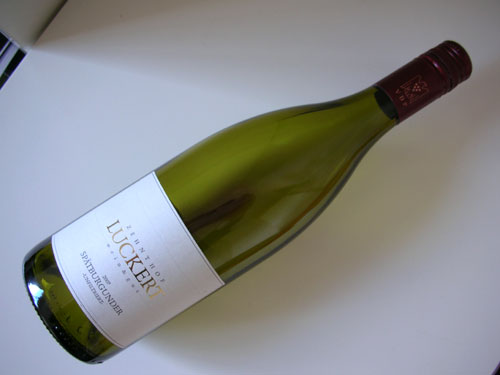Weingut Aufricht, Meersburger Sängerhalde, Sauvignon Blanc 2008
Tasted blind, and with surprising results, here.
Tasted blind, and with surprising results, here.
If you ask me to name a winemaker who has really impressed me with consistently, year for year letting the quality (let's avoid the word terroir here, shall we) of an outstanding vineyard shine, well, then I would probably name Theo Haart. Sure, there are others, but I have now tasted his late harvest Rieslings from the famous Piesporter Goldtröpfchen for the vintages 1999 and 2001-2008 (the 05 though is still sitting here, waiting for its day), and not only are they all first class wines, they are also very distinct and consistent in style. The '08 is no exception and, boring as it may sound when I write about Haart late harvest Riesling, just a lovely wine.

This is a story about a dialogue, a dialogue between English and German wine - or rather my personal experience of it. Moving from Germany to London made me see wine differently and I think I have benefited from this experience. In particular, it was a blending of national perspectives, perhaps even bias, that had some fruitful effects and made me look out for and experience things in wine I would otherwise not have done. While this is partly a personal story, it can also be read as a plea to look at wine in different ways and turn whatever national drinking bias we might have into a force that makes us see more, not less.

After having tried a few English Bacchus-based wines I was curious to see what I would make of a German representative of this variety (Bacchus was, after all, created in Germany). However, it is not that easy as Bacchus is not very popular in Germany. It is mostly blended into cheaper wines and not really a variety wine connoisseurs think of a lot, which is probably why none of my online wine merchants sell it. So I was pleased when, while visiting Munich and food shopping for a Wine Rambler committee meeting, I came across a Bacchus in a similar price range to the English ones I had tried. Little did I know what disappointment would lie ahead.

Sometimes, sometimes I smell the cork of a freshly uncorked bottle of wine and I know great things are ahead. Sometimes, sometimes I do not even have to get my nose close to the wine glass to sing and jubilate. Sometimes, sometimes I set a wine glass down in utter awe, in quiet yet powerful excitement because I have found a wine that is pure awesome. And guess what, I just had one of these moments.
Bavaria, home of the BMW, the original Disney castle and German red wine. Oh, wait, did I say 'German red wine'? Obviously, I should have said 'German beer' or something along those lines. However, I am just now looking at a bottle coming from Bavaria that features no lion or young maiden on the label; instead, it has a red screw cap and says 'Spätburgunder' (Pinot Noir) and 'unfiltriert' (unfiltered). And it looks, smells and tastes like a red wine. More importantly, it looks, smells and tastes like a good red wine. So while I am not telling you to forget about Bavarian lager, you may want to keep an eye out for red wine from the Bavarian wine growing region of Franken (Franconia).

Since the well-remembered Silvaner symposium, Wine Rambler full committee meetings have regularly featured a pair of wines with a characteristic similarity (grape variety and vintage, mostly) that we taste without knowing which is which. Is this a sensible thing to do? The detractors of tasting blind argue two things: It favours bolder, more easily understandable wines at the expense of quieter, more refined types, thereby contributing to a levelling of taste and the loss of originality and regionality in wine. It also, in their view, turns tasting wine, which should be about enjoyment and open minds, into a sort of competitive sport. Valid concerns, surely, but we keep finding that without putting your own palate to the test once in a while, you lay yourself open to the twin dangers of preconceived notions and of auto-suggestion ("Label says this has notes of ripe blackberries. Yeah, I think I'm picking them up..."). So we're stumbling on with the blind tastings.

Tasted blind, and very subjectively, here.
It has been a while, way too long, actually, since I reported on a wine made by the lovely people from the Haart winery. The winery is based in the village of Piesport, a name that is infamous in the UK for cheap wine, but famous among wine lovers for the Goldtröpfchen (little drop of gold) vineyard, one of the best at the Mosel. The Haart family has been making wine since the 14th century and the sweet Rieslings of Theo Haart, who runs the family estate with his wife and son, have an excellent reputation. For me they are also the embodiment of what I love about the Mosel style of winemaking.

I have written about so many Salwey wines recently, I almost feel bad to pay that much attention to a single producer. Almost, I said, because Salweys know what they are doing and I am in a Pinot (Noir, Blanc, Gris) phase anyway. So I will keep it sweet and short today in order not to repeat myself. Here it is, a blend of Chardonnay and Pinot Blanc/Weißburgunder:
